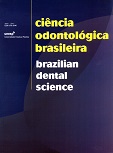Evaluation of apical leakage in root canals filled with different sealers
DOI:
https://doi.org/10.14295/bds.2012.v15i3.820Abstract
Objective: To evaluate the apical leakage exhibited by root canals filled with gutta-percha points and three different endodontic sealers. Material and Methods: Thirty-five human molars were used and had their palatal (maxillary molars) and distal roots (mandibular molars) sectioned, standardized and instrumented with Mtwo rotary system. The roots were filled through active lateral condensation technique and divided into three groups (n=10), according to the endodontic sealer employed: G1- AH Plus, G2- Fill Canal, G3- MTA Fillapex. All groups were filled by gutta-percha points and endodontic sealer. Gutta-percha points were immersed into sodium hypochlorite for 24 h to achieve disinfection. After the filling procedure, the roots were immersed into Indian ink for posterior diaphanization and obtainment of the images through stereomicroscopy. By analyzing the images in Adobe Illustrator CS5 software, the level of apical leakage was determined. The data obtained were submitted to Kruskal Wallis and Dunn tests, with level of significance set at 5%. Results: Statistically significant differences were found between G1 and G3. G2 did not show statistically significant differences. G1 exhibited the smallest apical leakage mean (12.85), followed by G2 (109.84) and G3 (101.15). Conclusions: Root canal obturation with gutta-percha points and AH plus sealer through lateral condensation technique provided lower apical leakage rates than the other endodontic sealers evaluated.Downloads
Downloads
Additional Files
Published
How to Cite
Issue
Section
License
Brazilian Dental Science uses the Creative Commons (CC-BY 4.0) license, thus preserving the integrity of articles in an open access environment. The journal allows the author to retain publishing rights without restrictions.
=================




























